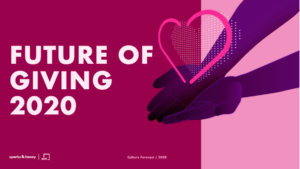
spark and honey: Future of Giving Report
This report explores the question: What are the cultural shifts impacting the future of giving, and what are the critical implications and opportunities for individuals and organization now and in the future? It is a collaboration between sparks & honey, a business strategy firm and the Morgridge Family Foundation.
The report defines the “giving ecosystem” expansively, encompassing private and public sectors, individuals and larger institutions and suggests that each plays a role within the cultural changes that bring forth the future of giving. The 135-page report is organized by five key consumer trends that will influence giving, summarizes a lot of key data, research and trends.
The report is chocked full of insights, but was particularly interested in their commentary on artificial intelligence for philanthropy and fundraising as Allison Fine and I have recently published our report, funded by the Gates Foundation, “Unlocking Generosity with Artificial Intelligence.” In our article for the SSIR Blog, Rehumanizing Fundraising with Artificial Intelligence we make the case that this is a pivotal moment for nonprofits to rethink fundraising and focus on donor retention rates. We also talk about the risks and need for more attention on the ethics of AI.
Here’s how the sparks & honey report frames the risks and potential for AI:
AI Risks And Potential
- AI is under the spotlight both for its immeasurable potential to expand innovation, but also for its capacity to expand inequities. Marginalized communities will be disproportionately affected by the adoption of AI, an imbalance that calls out for giving.
- The coronavirus has accelerated the use of AI, with technology stepping in for human interaction and efficiencies. Decision makers and business leaders are turning to AI for advancements, 40 percent of whom say they are currently implementing an AI project, or plan to do so in the short term. But the growing presence of AI is leaving its mark on minority communities and women, who are most at risk of being displaced by the effects of automation. Women are at the forefront of the AI debate, making up 57 percent of the workforce expected to be displaced by automation, according to the World Economic Forum. The Institute of Women’s Policy Research estimates that employment around office work, food services and production, which are heavily dominated by women, will be hit the hardest by workforce changes brought on by AI.
The report is also anticipating a shift to a more collaborative ecosystem in the social sector – something Allison and I wrote about in the Networked Nonprofit and have watched over the past ten years. Now the pandemic has given this approach more urgency and we will see more adoption.
Contagious Giving & Collaborative Survival
- The coronavirus pandemic has flipped the world on its head, disrupting the economy as well as social norms — both of which will leave a significant imprint on the organizations focused on giving and the people, companies and charities who give. Because of the economic burden of the pandemic, the motivations and drivers behind giving will undergo massive change, which will require many organizations to completely restructure and scale back operations, despite unprecedented need. At the same time, organizations from nonprofits to public- and private-sector companies will have to adapt and elevate their giving programs.
- Understand that motivations for giving are moving toward collective survival, demanding more sophisticated coordination among public- and private sectors, and new roles to identify and evaluate partners.
If you want to see the data about giving during the pandemic, the latest data from a number of sources show that giving in 2020 is up substantially and for all donation levels, but particularly for grassroots giving. The GivingTuesday Data Commons collaborated on the Q2 report of the Fundraising Effectiveness Project and the results are encouraging.
To leverage generosity for the long term, the combination of collaborative philanthropy with coordinated nonprofit program delivery, increased attention to re-humanizing fundraising, and using artificial intelligence equitably are key.

Leave a Reply